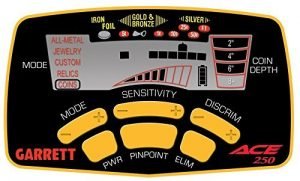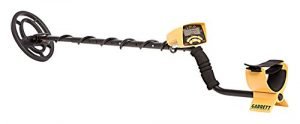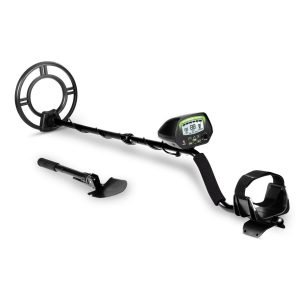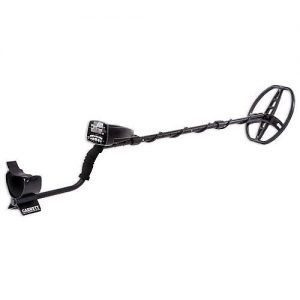[amazon table=”285″]
Top 3 All Round Metal Detectors
The reason people get into metal detecting varies, for some it is simply the thrill of finding something that has been buried for hundreds or maybe even thousands of years, for others it is more down to the chance of coming across a good hoard of treasure and being able to make a nice pay packet out of it. Headlines such as the following will often inspire newcomers to the hobby, however it is worth noting that you don’t always find something when you go out hunting and sometimes the best finds are the ones that have been made totally accidently.
So how do metal detectors actually work?
A metal detector is basically a coil of wire that has an electrical current going through it, the coil acts in a similar way to a magnet due to the electric that is running through it and the field it creates is what ‘finds’ the metal objects. To have a better understanding of how these devices work we need to look into the mechanics of what is actually going on inside the machines and this brief guide will give you the basics. There are three types of units these are electro magnet, induction and oscillation.
The electro magnet unit
An electro magnet is a coil of wire that is usually wound around a core that is made of iron, this enables the unit to produce magnetic field as long as the electrical current continues to flows through the coil. Electro magnets act like permeant magnet, meaning they are constantly on, unless they are switched off and the size of the fields they create varies depending on the size of the coil itself.
The strength of the magnetic field depends on several factors such as:
- The number of turns on the coil.
- The size of wire used to wind the coil.
- The voltage source applied to the coil.
Induction
Electromagnetic induction is made by an electric field by a fluctuating magnetic field. The electric field may be created in two ways, according to Faraday’s law of induction, 1, by the simple motion of a conductor cutting through the lines of magnetic field or 2, by a change in the magnetic field that is passing through a coil that is immersed in a non-constant magnetic field.
A little bit of history here for you:
In 1831 Michael Farraday first noticed that when a magnet is moved through a closed coil of wire, a current is created in the wire. The direction of the currents flow will create a magnetic field that works in the opposite direction to that of the change in the field produced by the magnet. Faraday then replaced the magnet with an electromagnet. He started with two coils were wound close to each other, the first was connected to a battery and the second to a galvanometer, which is used to measure small currents.
He observed movements in the galvanometers needle when the connection between the first coil and the battery was broken and remade. The currents created at those two moments flowed in opposite directions to each other. No current flowed in the second coil when a large, steady current flowed in the first. The significant discovery of the experiment was the change in the magnetic field. What he had managed to do was to build the world’s first transformer. The changing current in the first coil set up a time-varying magnetic field that penetrated to the second coil and set up an electromotive force in that coil, which made a current to flow there. However, transformers were not put into practical use until the discovery of alternating currents was made.
So far so good now if you can accept all this then we are doing well. There is now only one small piece missing in the jigsaw. The piece of metal itself, when it is detected will have a small current flowing inside it due to induction. The piece of metal will therefore act as an electro magnet as well. This new magnet will go against the magnetic field of the detector causing more current to flow in the detector’s coil. In other words, altering the inductance of the coil. We can measure this alteration on an Ammeter or by altering an audible tone.
Lastly, we have oscillation
Everything oscillates, and I do mean literally everything, oscillation basically means to vibrate. If an object vibrates at a certain rate, then it becomes a sound that the human ear can detect. The scientific name for this vibration is frequency.
So, the coil in your detector acts as part of an oscillator. (The knob you move alters the capacitance which alters the frequency so you can hear it). As the detector passes over a piece of metal then the inductance alters and the frequency alters and you realise you have made a find.
So now you have a basic understanding of how a metal detector works let us take a look at the three we will be reviewing today.
Garrett AT Pro Metal Detector Review – Our Number 1
Garrett is an American based company that came to life in 1964 and was the brain child of Charles and Eleanor Garrett, a husband and wife duo with a passion for metal detecting. The began making and selling their detectors from their own garage and over the next 50 odd years their business grew to unexpected levels. There are now three separate subdivisions of the company, Sports, Security and Countermine.
Within the sports division there are two sections that cover detectors for the American markets and those for the International market. In some cases, the machines are the same but there are a few reginal exclusives. Now let us take a look at the key features of this unit to see what it can offer you.
- Pro Mode Audio™: Proportional Audio and Tone Roll Audio™ features allow the you to hear the characteristics of a target as they would in a True All-Metal Mode.
- High-Res Iron Discrimination™ allows you to set the iron discrimination level from 40 different levels.
- The Digital Target ID offers a scale of 0 to 99 to help increase the user’s ability to distinguish one target’s conductivity from another.
- Iron Audio™: Allows the user to hear discriminated iron and to alter the detector’s mid-tone signal’s range accordingly
- Fast Recovery Speed: Allows greater ability to pick out good targets amongst trash
- All Terrain Versatility: Weatherproof housing designed for dusty, humid or wet environments; unit can be submerged to a maximum 10-foot depth.
- 15 kHz frequency: improved detection of small targets, gold nuggets, jewellery
- Ground Balance: automatic and manually adjustable for improved performance
- Graphic Target Analyzer™ (GTA): identifies target’s conductivity
- Continuous Coin Depth Indicator: to determine target depth
- Battery Condition Indicator: shows battery life continually
- Search Modes (Discrimination Patterns): 6 plus electronic pinpointing
- Select from Custom, Zero or Coins in Standard Mode or in Professional Mode
- Pinpoint
- Various interchangeable AT Pro search coils available.
That is a lot of features and the Garrett AT Pro (VIEW PRICE HERE!) is an excellent piece of kit that will not disappoint or let you down.
Summary
Features – Pro Mode Audio – High-Res Iron Discrimination – Digital Target ID – Iron Audio – Fast Recovery Speed – All Terrain Versatility – Graphic Target Analyzer – Continuous Coin Depth Indicator -Battery Condition Indicator – Search modes, Custom, Zero or Coins in Standard Mode – Pinpoint.
Pricing – High End
VIEW THE LATEST PRICE NOW!
Garrett Ace 250 Metal Detector Review – Number 2
 As we have already had an introduction to Garrett I will not bother going over it again, instead we can jump straight into the key features this unit has to offer.
As we have already had an introduction to Garrett I will not bother going over it again, instead we can jump straight into the key features this unit has to offer.
- Electronic Pinpointing to precisely locate targets and speed recovery.
- Accept/Reject Discrimination: to modify discrimination patterns.
- It has five search modes which allows you to select pre-set discrimination pattern or create your own.
- Continuous Coin Depth Indicator which works to determine target depth.
- Battery Condition Indicator that shows battery life continually.

- There are a number of Interchangeable ACE series search coils available.
- Expanded Target ID Legend: easy-to-read above large LCD screen.
- Pushbutton Controls: with One-Touch operation.
- Other features: 3-piece travel/storage, disassembles to 24
- Adjustable arm cuff
- Quarter-inch (1/4″) size headphone jack.
- The search modes are – All Metal (Zero), Jewellery, Custom, Relics, Coins, Pinpoint.
Again, that is an impressive list of features and as you would expect from a company with the years of experience behind it the Garrett Ace 250 is an excellent all round machine that will keep you hunting for hour and hours.
Summary
Features – Electronic Pinpointing – Accept/Reject Discrimination – Five Search Modes – Continuous Coin Depth Indicator – Battery Condition Indicator – Interchangeable ACE series search coils – Expanded Target ID Legend – Pushbutton Controls – 5 Search Modes All Metal, Jewellery, Custom, Relics, Coins, Pinpoint.
Pricing – Mid Range
VIEW THE LATEST PRICE NOW!
INTEY LCD Display Metal Detector 9.8 Review – Number 3
 The last machine is made by Intey and is a much more basic model than those already mentioned, but it is a good all round machine if you are new to this hobby and you are not ready to shell out a lot of cash for a more technologically advanced option. The key features of this model include:
The last machine is made by Intey and is a much more basic model than those already mentioned, but it is a good all round machine if you are new to this hobby and you are not ready to shell out a lot of cash for a more technologically advanced option. The key features of this model include:
- The detector comes with high sensitivity and strong ability of discrimination.
- With this metal detector, you can hunt for coins, relics, jewellery, gold, and silver just about anywhere.
- LCD DISPLAY: Shows the probable type of metal, the depth of the target, range of DISC & NOTCH, the level of SENS, and battery condition. It also has numeric display for target.
- PP FUCTION: Pinpoints the location of the target accurately.
- LIGHT: Used in dark area. Press MENU to select LIGHT. Then press + or – to adjust the level (0-9) of LIGHT. The level will be displayed on the LCD.

- OPERATION MODES: DISC and NOTCH. DISC-discriminates what kind of metal being detected. NOTCH – to select the target to be notched, it means this target will be notched during the detection and the detector will have no reaction to the notched target.
As you can see this machine isn’t of the same level of the Garrett’s but then again, it’s not in the same price bracket either which can make a huge difference if you are in a tighter budget. It can still discriminate between different metals it’s just not as fancy as the other two.
Summary
Features – High Sensitivity – Strong Discrimination levels – LCD display screen – Pinpoint function – On-board light – 2 operation modes – Waterproof.
Pricing – Affordable
VIEW THE LATEST PRICE NOW!
Verdict
Before you buy any new piece of equipment you need to understand what it does and how much time you are actually going to devote to using it. There is no point in spending hundreds of pounds on a metal detector if you are only going to get it out once in a blue moon. With that said the winner of today’s review is going to the Garrett AT Pro. The why us simple, it is the best all round machine not only because it has more features than the others but because it can be used to find gold as well as all the other standard types of metals out there. If you have been doing this hobby for a while and are in the market for a new machine then this is the one to go for.
